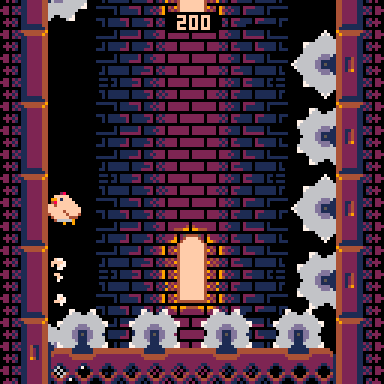Pico8 Games
-
FrancoB

- J+ member of the year finalist!
- Posts: 4795
- Joined: June 8th, 2009, 10:42 pm
- Location: Oxfordshire
- eBay: francosquashking
- Initials: FRN
Re: Pico8 Games
LED display looks great Joe  I know you put a lot of work in to get it up and running but it looks ace. I bet it looks even better IRL
I know you put a lot of work in to get it up and running but it looks ace. I bet it looks even better IRL 
-
pubjoe

- Fosters Political Ambitions
- Posts: 10027
- Joined: August 19th, 2008, 8:58 am
- Location:
Re: Pico8 Games
Thanks. It looks MUCH better in person. The colours and brightness are glorious. It's depressing to see the resulting photographs of these.
-
pubjoe

- Fosters Political Ambitions
- Posts: 10027
- Joined: August 19th, 2008, 8:58 am
- Location:
Re: Pico8 Games
-
pubjoe

- Fosters Political Ambitions
- Posts: 10027
- Joined: August 19th, 2008, 8:58 am
- Location:
Re: Pico8 Games
I don't know how to represent this but if only a few LEDs are lit and I cheat up the saturation then it kind of looks close, ish.

Brilliant puzzle Game that. Trichromat.
https://www.lexaloffle.com/bbs/?tid=140628

The game cries out for pure primary colours which are absent from Pico8's palette. I discovered I could force them to the LED matrix by reducing bits per colour in the driver.
-
arcnl
- Posts: 712
- Joined: September 16th, 2012, 1:46 pm
- Location: The Netherlands
Re: Pico8 Games
What screen is it and how did you hook it up? It looks pretty good for pico8 usage 
-
pubjoe

- Fosters Political Ambitions
- Posts: 10027
- Joined: August 19th, 2008, 8:58 am
- Location:
Re: Pico8 Games
I used four of these but they were cheaper at time of order:
https://a.aliexpress.com/_EGdlgqQ
Also:
- A Pi4 (I've tried a Zero2W but can't quite get it up to speed)
- A 5v 15a PSU
- Some IDC cables of different lengths.
- A 'HUB75' adapter
- A week of headache

My lad made me some joints in TinkerCAD.
https://a.aliexpress.com/_EGdlgqQ
Also:
- A Pi4 (I've tried a Zero2W but can't quite get it up to speed)
- A 5v 15a PSU
- Some IDC cables of different lengths.
- A 'HUB75' adapter
- A week of headache

My lad made me some joints in TinkerCAD.
-
geotrig

- Potato!
- Posts: 7764
- Joined: December 5th, 2008, 1:14 pm
- Location: ._.
- eBay: ._.
Re: Pico8 Games
thats pretty cool pubjoe  ,love it , whats the pico8 running on the pi4 ? i didnt really process what was in the pic before as i was distracted by your stick
,love it , whats the pico8 running on the pi4 ? i didnt really process what was in the pic before as i was distracted by your stick 

<trk>:I remember catching a big fat one and my friend said "throw it back in, that one already tastes like wood"
-
cools

- Armed Police Buttrider
- Posts: 13588
- Joined: August 17th, 2008, 4:49 pm
- Location: Wales, United Kingdom
- eBay: hordarian
- Initials: CLS
-
pubjoe

- Fosters Political Ambitions
- Posts: 10027
- Joined: August 19th, 2008, 8:58 am
- Location:
Re: Pico8 Games
Yeah Pi4. Well, Pi400 but it's the same thing. It uses hzeller's LED library and Jenissimo's program which takes continuous screenshots of Pico8 to display on the LED matrix. I made a video to test my setup and joy_test.p8 responds after 1-2 frames of latency which I'm guessing is about the same as any normal screen used with Pico8.geotrig wrote: May 2nd, 2025, 7:22 am thats pretty cool pubjoe,love it , whats the pico8 running on the pi4 ?
These panels have a lot of potential for retrogaming. A 256x256 matrix would be great for classic arcade games. There's currently a program for Game Boy on LEDs. My 128x128 matrix set would use downscaling, but I kinda feel GB with its inverted greyscale / light backgrounds is one system that wouldn't fit so well. Maybe I'm wrong. Pico 8 is perfect anyway.
-----
Lava Joe goes mental at 2500ft

-
pubjoe

- Fosters Political Ambitions
- Posts: 10027
- Joined: August 19th, 2008, 8:58 am
- Location:
Re: Pico8 Games
https://www.lexaloffle.com/bbs/?tid=54986

Very simple but fun. I took back the house record with this score:

I'm getting better at photographing this thing, with editing.


Very simple but fun. I took back the house record with this score:

I'm getting better at photographing this thing, with editing.


